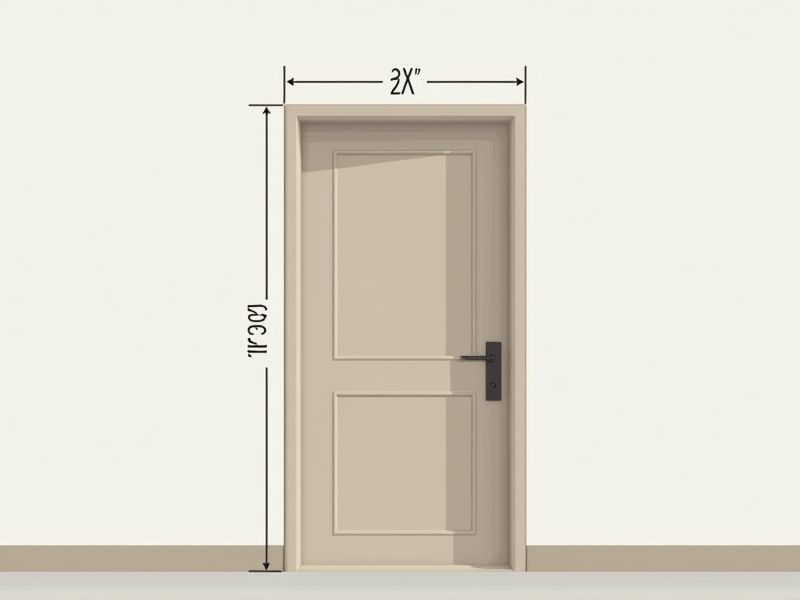
When selecting a standard house door, it's useful to know common dimensions to ensure a good fit. Most residential exterior doors in the U.S. are typically 36 inches wide and 80 inches tall, though widths of 32 and 34 inches are also common. Interior doors are often slightly narrower, with standard sizes being 24, 28, 30, 32, or 36 inches wide and usually 80 inches high. Knowing these measurements will help you plan renovations or replacements efficiently, and ensure compatibility with frames and hardware.
Width
The standard width for a residential house door typically ranges from 28 to 36 inches, with 32 inches being the most common choice for ease of access. Wider doors, such as 40 inches, are often used for wheelchair accessibility or to accommodate large furniture. In new construction, it's important to consider the rough opening, which should be larger than the door itself, usually about 2 inches wider and taller. When selecting your door, ensure adequate space for trims and hardware, allowing for optimal functionality and aesthetic appeal.
Height
The standard height for residential house doors typically measures 80 inches, or 6 feet 8 inches. This height ensures accessibility for most individuals, accommodating a wide range of activities, from moving furniture to allowing tall occupants to pass comfortably. In some cases, custom doors may reach heights of 96 inches, or 8 feet, providing a grander entrance and enhancing the aesthetic appeal of your home. Choosing the right door height not only impacts functionality but also influences the overall design and flow of your living space.
Thickness
The standard thickness for residential doors typically ranges from 1 3/4 inches to 2 1/4 inches, ensuring durability and security. A thicker door not only enhances insulation but also improves soundproofing, making your home quieter. For added strength, you may consider solid-core doors, which can weigh up to 100 pounds. Choosing the right thickness is crucial for safety and energy efficiency in your home.
Material
The standard for house doors typically emphasizes durability and insulation, with materials such as solid wood, fiberglass, and steel being the most popular choices. Solid wood doors, like oak or mahogany, offer excellent aesthetics and natural insulation properties, while fiberglass doors provide the look of wood with added resistance to moisture and warping. Steel doors are known for their robust security features and energy efficiency, achieving up to a 90% efficiency rating when properly installed. For energy savings and security assurance, selecting high-quality doors with proper weather stripping and insulation is essential in optimizing your home's entryways.
Frame Size
The standard frame size for house doors typically measures 80 inches in height and 36 inches in width. This size provides an optimal opening for accessibility, accommodating most residential door styles. Common materials for the frame include wood, metal, or fiberglass, which ensure durability and insulation. When selecting a door, consider the frame's thickness, generally ranging from 4 to 6 inches, to ensure compatibility with your existing wall structure.
Hinges
Hinges are crucial components that ensure the smooth operation and security of house doors, typically available in various materials such as stainless steel, bronze, and plastic. A standard door hinge has a weight capacity ranging from 30 to over 150 pounds, accommodating both residential and commercial needs. When selecting hinges, consider factors such as the door's size, thickness, and frequency of use, as these elements directly influence hinge durability and functionality. For optimal performance, choose hinges with a minimum 5-knuckle design for strength, along with rust-resistant finishes to extend their lifespan.
Clearance
The standard clearance height for a house door typically measures around 80 inches (203 cm), ensuring easy access for most individuals. A width clearance of 36 inches (91 cm) is commonly recommended for accessibility, allowing for smoother entry and exit, especially for individuals using mobility aids. Maintaining a proper clearance also prevents operational issues such as dragging or sticking, which can occur with inadequate space. When installing your doors, ensure to consider both the structural framing and the finish flooring to achieve optimal clearance alignment.
Threshold
The threshold of a standard house door typically measures between 1 to 2 inches in height, providing a crucial barrier against weather elements and pests. This component, often constructed from durable materials like wood, aluminum, or composite, plays a vital role in energy efficiency by minimizing drafts. Proper installation is essential, as a well-aligned threshold can enhance your home's security and overall aesthetics. Regular maintenance, such as sealing cracks and cleaning debris, helps prolong the lifespan of your door threshold and ensures optimal performance.
Swing Direction
When choosing a house door, the swing direction is crucial for functionality and aesthetics. A door can swing inward or outward; an inward-swinging door typically offers a more secure environment while maximizing exterior space. In contrast, an outward-swinging door is favored in areas with limited interior space but may require clearance on porches or sidewalks. Ensure your door's swing direction aligns with your living area's layout and traffic flow to enhance accessibility and comfort.
Handle Height
The standard handle height for residential doors is typically 36 inches from the floor, accommodating the average user's reach while ensuring accessibility. For children or individuals with disabilities, a lower placement around 30 to 32 inches may be more appropriate. Adjusting handle height can enhance comfort and usability, especially in homes where young children or elderly individuals reside. You can improve your home's accessibility by considering door handle placement that meets the needs of all inhabitants.
